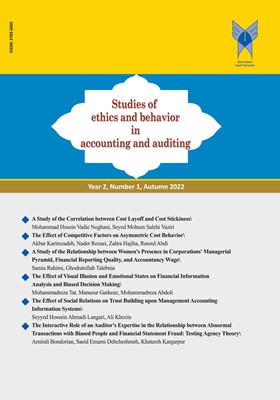-
-
List of Articles
-
Open Access Article
1 - A Study of the Correlation betweenCost Layoff and Cost Stickiness
Mohammad Hosein Vadeei Noghani Seyed Mohsen Salehi Vaziri -
Open Access Article
2 - The Effect of Competitive Factorson Asymmetric Cost Behavior
Akbar Karimzadeh Nader Rezaei Zohreh Hajiha Rasoul Abdi -
Open Access Article
3 - A Study of the Relationship between Women's Presence in Corporations' Managerial Pyramid, Financial Reporting Quality, and Accountancy Wage
Somayeh Rahimi Godratollah Talebnia -
Open Access Article
4 - The Effect of Visual Illusion and Emotional Stateson Financial Information Analysisand Biased Decision Making
MohamadReza Tat Mansour Garkaz MohamadReza Abdoly -
Open Access Article
5 - The Effect of Social Relations on Trust Buildingupon Management Accounting Information Systems
Seyed hossein Ahmadi Langari Ali Khozein -
Open Access Article
6 - The Interactive Role of an Auditor's Expertisein the Relationship between Abnormal Transactionswith Biased People and Financial Statement Fraud:Testing Agency Theory
Amirali Bandarian Saeid Emami Dehcheshmeh Khatereh Kargarpur
-
The rights to this website are owned by the Raimag Press Management System.
Copyright © 2021-2025







